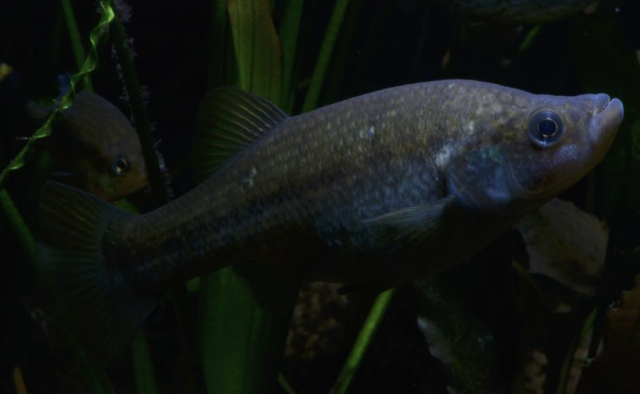When we talk about mini-monster livebearers, there really aren't many representatives. Sure, there is the nippy Ameca and Illyodon and the predatory Belenosox but there is one glaring ommission.

Enter Alloophorus Robustus, the platy from hell. It is a clear predator, hiding near rocks and plants snacking on smaller livebearers. Unlike other livebearers, adults from this species will eat all their fry making a breeding colony impossible. That aside, the fry aren't too hard to care for as they will accept artemia and bbs unlike the other predatory livebearer (cough Belenosox). Beyond that, they seem like pretty reasonable fish. Keep them in temperatures below 24 C and in a large enough tank as they can get to 5-6", making them the second largest goodied in the world. They are very breedable despite the fact that they are uncommon in their native range. Feeding is very easy for them as they will take virtually everything although high quality live or frozen foods may be necessary to ensure healthy fry.
They seem to be a great fish despite their drab coloration and I hope to get my hands on them after working with some other goodieds that are more common in the hobby. Its really a shame that they are nearly unattainable in the hobby with only a few people working with them in the states. I feel that they are the ultimate predatory livebearer due to their predatory nature, distinctive look, large size, and ease of care. All in all, I hope that they, along with other goodieds which are even rarer in the wild could become more prevalent in the hobby because they are very rewarding.

Enter Alloophorus Robustus, the platy from hell. It is a clear predator, hiding near rocks and plants snacking on smaller livebearers. Unlike other livebearers, adults from this species will eat all their fry making a breeding colony impossible. That aside, the fry aren't too hard to care for as they will accept artemia and bbs unlike the other predatory livebearer (cough Belenosox). Beyond that, they seem like pretty reasonable fish. Keep them in temperatures below 24 C and in a large enough tank as they can get to 5-6", making them the second largest goodied in the world. They are very breedable despite the fact that they are uncommon in their native range. Feeding is very easy for them as they will take virtually everything although high quality live or frozen foods may be necessary to ensure healthy fry.
They seem to be a great fish despite their drab coloration and I hope to get my hands on them after working with some other goodieds that are more common in the hobby. Its really a shame that they are nearly unattainable in the hobby with only a few people working with them in the states. I feel that they are the ultimate predatory livebearer due to their predatory nature, distinctive look, large size, and ease of care. All in all, I hope that they, along with other goodieds which are even rarer in the wild could become more prevalent in the hobby because they are very rewarding.


